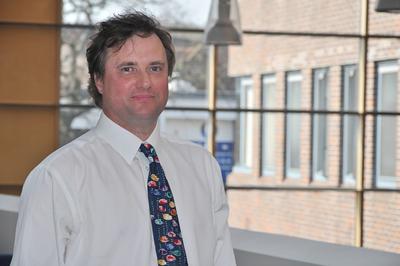New radar system inspired by dolphins to detect hidden surveillance and explosive devices

Inspired by the way dolphins hunt using bubble nets, scientists at the University of Southampton, in collaboration with University College London and Cobham Technical Services, have developed a new kind of radar that can detect hidden surveillance equipment and explosives.

The twin inverted pulse radar (TWIPR) is able to distinguish true ‘targets’, such as certain types of electronic circuits that may be used in explosive or espionage devices, from ‘clutter’ (other metallic items like pipes, drinks cans, nails for example) that may be mistaken for a genuine target by traditional radar and metal detectors.
The new system has been developed by a team led by Professor Tim Leighton from the University’s Institute of Sound and Vibration Research and is based on his unique sonar concept called twin inverted pulse sonar (TWIPS). TWIPS exploits the natural abilities of dolphins to process their sonar signals to distinguish between targets and clutter in bubbly water. Some dolphins have been observed to blow ‘bubble nets’ around schools of fish, which force the fish to cluster together, and their sonar would not work if they could not distinguish the fish from the bubbles.
The technique uses a signal consisting of two pulses in quick succession, one identical to the other, but phase inverted. Professor Leighton, along with Professor Paul White and students Dan Finfer and Gim Hwa Chua, showed that TWIPS could enhance linear scatter from the target, while simultaneously suppressing nonlinear scattering from oceanic bubbles.
Professor Leighton’s team proposed that the TWIPS method could be applied to electromagnetic waves and that the same technique would work with radar. They teamed up with Professor Hugh Griffiths and Dr Kenneth Tong of University College London and Dr David Daniels of Cobham Technical Services to test the proposal, by applying TWIPR radar pulses to a ‘target’ (a dipole antenna with a diode across its feedpoint - typical of circuitry in devices associated with covert communications, espionage or explosives) to distinguish it from ‘clutter’ (represented by an aluminium plate and a rusty bench clamp). In the test, the tiny target showed up 100,000 times more powerfully than the clutter signal from an aluminium plate measuring 34 cm by 40 cm.
The study, ‘Radar clutter suppression and target discrimination using twin inverted pulses’ is published in the journal Proceedings of the Royal Society A.
Professor Leighton says: “As with TWIPS, the TWIPR method distinguishes linear scatterers from nonlinear ones. However, in scenarios for which TWIPS was designed, the clutter scatters nonlinearly and the target linearly - while in situations using TWIPR, these properties are reversed.
“For instance, certain electronic components can scatter radar signals nonlinearly if driven by a sufficiently strong radar signal, in contrast to naturally occurring objects which tend to scatter linearly.”
Given that the diode target measured 6 cm in length, weighed 2.8 g, costs less than one Euro and requires no batteries, it allows the manufacture of small, lightweight and inexpensive location and identification tags for animals, infrastructure (pipelines, conduits for example) and for humans entering hazardous areas, particularly where they might be underground or buried. These tags can easily be tuned to scatter-specific resonances to provide a unique identifier to a TWIPR pulse, what Professor Leighton calls ‘the TWIPR fingerprint’.
Buried catastrophe victims not carrying such tags might still be located by TWIPR, as it can carry the bandwidth to search for mobile phone resonances, offering the possibility of locating victims from their mobile phones, even when the phones are turned off or the batteries have no charge remaining.
Professor Leighton adds: “In addition to the applications discussed above, such technology could be extended to other radiations, such as magnetic resonance imaging (MRI) and light detection and ranging (LIDAR), which, for example, scatters nonlinearly from combustion products, offering the possibility of early fire detection systems.”
Related Staff Member
Bubble acoustics
Using bubbles to transform medicine, develop ultrasonic cleaning and learn more about whales and dolphins
Pioneering research into bubble acoustics is developing exciting applications in several fields. Professor Tim Leighton and colleagues in the Institute of Sound and Vibration Research (ISVR) are discovering new ways of understanding the oceans, delivering drugs and medical procedures and even making cleaning systems work more efficiently.
Notes for editors
1. A copy of the paper ‘Radar clutter suppression and target discrimination using twin inverted pulses’ is available from Media Relations on request.
2. A Royal Society video explaining the operation of the sonar system TWIPS is available at http://rspa.royalsocietypublishing.org/content/early/2012/07/17/rspa.2012.0247/suppl/DC1
Videos of a TWIPR experiment are available in the supplementary material that is supplied with the paper.
3. The University of Southampton is a leading UK teaching and research institution with a global reputation for leading-edge research and scholarship across a wide range of subjects in engineering, science, social sciences, health and humanities.
With over 23,000 students, around 5000 staff, and an annual turnover well in excess of £435 million, the University of Southampton is acknowledged as one of the country's top institutions for engineering, computer science and medicine. We combine academic excellence with an innovative and entrepreneurial approach to research, supporting a culture that engages and challenges students and staff in their pursuit of learning.
The University is also home to a number of world-leading research centres including the Institute of Sound and Vibration Research, the Optoelectronics Research Centre, the Institute for Life Sciences, the Web Science Trust and Doctoral training Centre, the Centre for the Developmental Origins of Health and Disease, the Southampton Statistical Sciences Research Institute and is a partner of the National Oceanography Centre at the Southampton waterfront campus. https://www.southampton.ac.uk/
For further information contact:
Glenn Harris, Media Relations, University of Southampton, Tel: 023 8059 3212 , email: G.Harris@soton.ac.uk
www.soton.ac.uk/mediacentre/
Follow me on twitter: https://twitter.com/@glennh75
Follow us on twitter: http://twitter.com/unisouthampton
Like us on Facebook: www.facebook.com/unisouthampton
